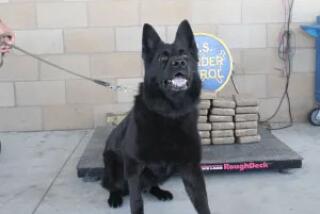The Drug Dogs: It’s a Fetish With Them
- Share via
Not all dogs are equals, at least when it comes to sniffing out marijuana, cocaine, heroin and other narcotics. Dog trainer Dan LaMaster says you have to think of it like the Olympics: some mutts are simply better than others and not everyone can run with the elite.
“There are a lot of smart dogs, intelligent dogs, but what we’re looking for is that something extra,” says LaMaster, owner of Master K-9 in Cherry Valley. “Some people breed dogs for their looks. We’re looking for genetic traits that tell us this dog can use his nose.”
LaMaster’s Riverside County canine academy is among a growing number of private businesses devoted to training dogs to sniff out narcotics hidden in the most unusual places. A trainer since 1976, LaMaster’s school has graduated more than 150 dogs for police work, a third of them with a specialty in narcotics detection.
To start, LaMaster and other trainers say they look for aggressive dogs with strong play instincts and a good nose. Master K-9 primarily uses German shepherds and the Belgian malinois, but other trainers--including those at the U.S. Customs Service, who prefer pound dogs--say any mongrel can do the job with the proper training.
The dogs usually start training around the age of 1 1/2 and undergo five to eight weeks of intensive schooling. The instruction method is simple enough: after learning basic commands, they are taught the odors of various narcotics and rewarded when they make a “hit.”
“In the beginning it is a lot of easy repetition, and we progressively make it more challenging and realistic,” LaMaster says. “At the end we use conflicting smells. We might have drugs inside some food, like fish, and then put that in an ice box. The dog has to distinguish among the other food inside and find the one with the drugs in it.”
Each time the dog finds the drug, it is rewarded with a playful romp with its trainer and a toy, usually a dishcloth-type towel or a piece of rubber or plastic tubing.
The dogs are eventually subjected to a rigorous field search for narcotics. If they pass, they are certified as trained narcotics dogs. Still, they must return periodically for follow-up training.
LaMaster says that if a dog is properly trained, playtime with the toy becomes its sole reason for living.
“We want to see the dog spend three minutes trying to get to a toy he can’t reach,” he says. “You want dogs that will pass over a piece of hot dog or liver just to find the narcotics. . . . It has to be a fetish with them.”
More to Read
Sign up for Essential California
The most important California stories and recommendations in your inbox every morning.
You may occasionally receive promotional content from the Los Angeles Times.













